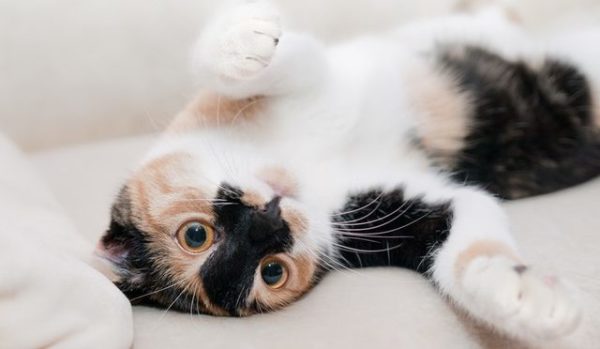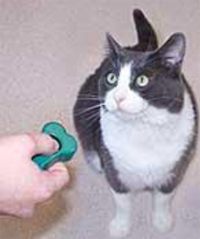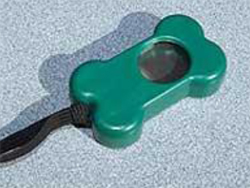Clicker Training your Cat
by Ontario SPCA and Humane Society | Cat Care | January 10, 2019
 Clicker training is a fun and effective way to help teach a wide variety of animals, from cats and dogs to marine mammals, zoo animals, horses and even fish. Unlike traditional training, which relies on commands and compliance, clicker training is more of a game. It presents an interesting challenge to cats. Instead of simply being handed treats as freebies, your cat is inspired to exercise her intelligence and to figure out different ways she can earn rewards (problem solve). You will walk away from clicker sessions happy that your cat is repeating behaviours you like – and your cat will walk away certain that she is training you to click!
Clicker training is a fun and effective way to help teach a wide variety of animals, from cats and dogs to marine mammals, zoo animals, horses and even fish. Unlike traditional training, which relies on commands and compliance, clicker training is more of a game. It presents an interesting challenge to cats. Instead of simply being handed treats as freebies, your cat is inspired to exercise her intelligence and to figure out different ways she can earn rewards (problem solve). You will walk away from clicker sessions happy that your cat is repeating behaviours you like – and your cat will walk away certain that she is training you to click!
What is clicker training?
A clicker is a small plastic box with a flexible steel plate inside which, when pressed, makes a double click sound. It comes in many shapes and colours and is available at most pet stores. With the clicker you can make a distinct sound that tells your cat that he just did something you like (made the right choice) – and promises a reward. Therefore when you don’t click and treat, you’re telling him he made the wrong choice and that he should try something else. Because the click is always paired with a treat you motivate your cat to figure out what he just did “right,” to repeat it, and to come up with new ways he can earn rewards. Simply by rewarding the right choices and ignoring the wrong choices, the behaviours you like will begin to happen more frequently.
Clickers aren’t the only tools used to mark “right choices.” Trainers of deaf animals often use a flash of light and dolphin trainers use whistles. Many dog trainers use a sound or word such as “Yes.” With cats the unique and precise sound of the clicker typically yields the best results.
 What should you “click”?
What should you “click”?
 Observe your cat and see what behaviours she performs naturally. For example, does she like to roll over on her back, retrieve crumpled balls of paper, jump onto different surfaces or take paw swipes at objects you dangle? Also, consider behaviours that are useful that you might want to encourage, such as coming when called, using her scratch pad or even staying still for short periods.
Observe your cat and see what behaviours she performs naturally. For example, does she like to roll over on her back, retrieve crumpled balls of paper, jump onto different surfaces or take paw swipes at objects you dangle? Also, consider behaviours that are useful that you might want to encourage, such as coming when called, using her scratch pad or even staying still for short periods.Clicking these and other behaviours can help inactive or elderly cats to become more playful and energetic, and overactive or aggressive cats to become calmer. Best of all, creating a new and fun way to communicate can bring you and your cat closer together. Below are three steps to help you and your cat discover the joys of clicker training.
Step 1: “Charging” your clicker. At first the clicker will be meaningless to your cat – just a plastic noisemaker. To make it valuable to your cat – and to make him motivated to work for it – you need to associate it with food or something else the cat loves. This is called “charging the clicker.” To charge the clicker simply click and immediately give your cat a treat. After a number of repetitions you will start to see your cat look at you expectantly after each click in anticipation of a treat.
Some cats may be frightened of the click at first. To help prevent any fear start by clicking with the clicker in your pocket, or with adhesive tape layered over the metal tab so the sound is muffled. Once the cat reacts positively to the clicker you can take it out of your pocket or get rid of the tape.
Step 2: Clicking behaviours you like. Start to click and treat when your cat does something you like. Correct timing is essential. If it’s a finished behaviour, such as lying down, click the moment she’s laid down. If it’s an ongoing behaviour, such as following you, you can click and treat periodically during the activity. Or, if you’re working on a larger training goal, such as getting your cat to come, break the training into smaller learning blocks and click and treat her for closer and closer approximations (think “baby steps”). This is called “shaping.” For example, you might click and treat your cat at first for simply turning his head towards you, later for taking several steps towards you, and finally for walking up to you.
Step 3: Adding a verbal cue. For some behaviours, such as “Come,” you may want to add a verbal cue. At this stage stick to clicking for the behaviour only when it follows the verbal cue – and ignore the behaviour when it is performed spontaneously. You can help your cat by trying to time it so that you say the word just before your pet is about to engage in the behaviour, or by encouraging him to perform (e.g. say “Come” then wave a treat or toy or shake his dinner so he starts to approach).

Respond to his name. Begin by simply clicking and treating whenever your cat looks at you. Later start saying your cat’s name in a friendly voice. If he looks at you click and treat. You may need to encourage him to look at you at first by waving a toy or treat or shaking his food. You can toss the treat to him or give it to him when he comes up to you to collect it. Once your cat responds reliably to his name you can try using it to interrupt behaviours you don’t like, such as stalking.
Come. To start, click and treat whenever your cat looks at you or approaches. When she is responding well to the clicker you can introduce the word “Come.” Call out your cat’s name in a friendly tone and say “Come.” In the beginning you might click and treat your cat for simply turning her head towards you, later for taking several steps towards you, and finally for walking up to you. If she needs encouragement start by sitting on the floor, waving treats, shaking a toy or scratching the floor in front of you. Feed the treat by dropping it near you or give it to her from your hand when she comes to collect it.
Target an object. Targeting teaches your cat to touch an object – typically a stick-like object such as a chopstick or even a pencil – and to follow it. To start, hold the target an inch or two in front of your cat and click or treat the instant she looks, sniffs or touches it (rub some food on the tip if needed). Repeat a bunch of times in a row, clicking and treating any interest your cat shows in the target. In later sessions you could try placing the target further away from your cat so he has to take a step or two towards it, offering the target when your cat is in motion, or seeing if you can get your cat to follow it. Targeting can simply be a fun activity (you can get creative with how you use it) – or it can be used to help redirect behaviours you don’t like such as pouncing, scratching or biting.
Jump through a hoop. Clicker training can be used to teach your cat to do a mini agility course you set up. While not all cats will take to agility, it can be fun to see if you can get your cat interested in some mini obstacles. First, show the cat a hoop standing up on the floor. If she touches the hoop to investigate it, click and treat. (You may need to start by simply clicking and treating if your cat looks at it.) If your cat voluntarily walks through the hoop at any time, click and treat as she steps through it (don’t wait until she’s already through it and walking away!). You can encourage your cat to walk or jump through the hoop by placing a trail of treats that pass through the hoop or by throwing a treat through the hoop if she likes to chase. Make sure the hoop is secure so that it doesn’t fall over.
Training tips
- Keep your sessions as simple as possible. Reward all correct choices and ignore all wrong choices.
- Sessions should be short – two or three minutes is ample. Try to end the session before your cat gets bored.
- Start with a clear goal in mind. Break the task down into small steps. Only go to the next step when he’s reliably mastered the first step. At times you may need to go back a step before moving forward.
- Ideally, the click should happen at the exact moment the behaviour occurs to give your cat a clear idea of the behaviour you want him to repeat. To practice your timing try dropping a ball and clicking the instant the ball hits the ground.
- Use a special treat or favorite meal as a reward. If you’re using food, make sure it is broken into tiny pieces so that you are not over feeding your cat. Train before meals – not immediately after.
- Training that fails is typically traced to one of three training errors: failing to click at the right moment, trying for too much too soon (you need to break the training goal down into smaller steps) and too few rewards (making the animal frustrated).
Categories
Testimonial
For every animal you save
For every animal you save, every animal who feels loved in their last moments, and for everything else you do; thank you and God Bless.
